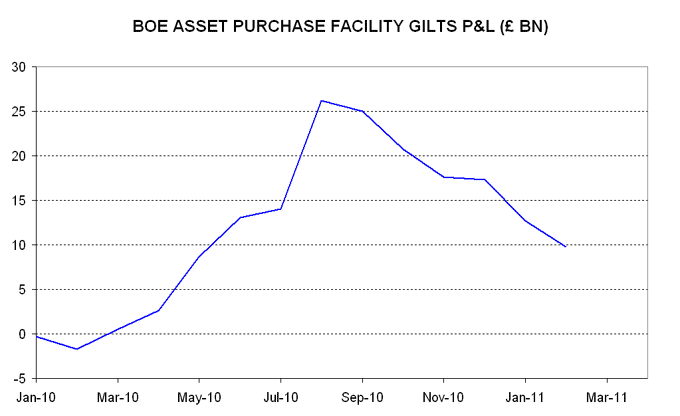BoE gilt purchase profits down sharply
The mark-to-market profit on the Bank of England’s gilt purchase programme has fallen from an estimated £26 billion in August to £10 billion as gilt yields have risen to a nine-month high – see chart. A further 50 basis point increase in yields would be sufficient to push the scheme into a loss.
Very roughly, a 10 basis point change in yields affects the P&L by £2 billion.
The Bank bought £198 billion of gilts between March 2009 and January 2010, initially of between five and 25 years' maturity although the range was later widened. The calculations are based on a 15-year gilt. Weighted by the Bank's monthly purchases, the average 15-year redemption yield was 4.16% over March 2009-January 2010, slightly below the current 4.25%, suggesting a capital loss of about £3 billion.
Capital erosion, however, has been more than offset by net interest income of an estimated £13 billion as the Bank has “played the curve” by creating reserve money on which it has paid Bank rate of 0.5% to finance its higher-yielding gilt portfolio.
The P&L of the purchase programme is not currently included in the fiscal deficit measure targeted by the government – public sector net borrowing excluding temporary effects of financial interventions – but will be when the scheme closes, presumably after the gilts are sold back to the market.
The Bank was right to initiate asset purchases to alleviate a liquidity squeeze in early 2009 although the subsequent expansion of the programme was questionable. It would be unfair to judge the success of the scheme simply on the basis of its final P&L but a large loss would be embarrassing for officials already under attack for their handling of the financial crisis and failure to predict the current inflation overshoot.


Reader Comments (2)
At end-2009, the UK had a total net worth, including financial assets, of some £6,669 billion (source, ONS) - or £6.67 trillion in US terminology.
Since the Bank of England embarked on its programme of QE, Sterling has depreciated by anywhere from 20-40% against a range of emerging/developing economy currencies. QE was not responsible for all of that, but it seems not unreasonable to suppose that it was at least a contributory factor.
Even taking the lowest figure of 20%, that represents a diminution in the net worth of the UK of more than £1.3 trillion.
To suggest that QE made a £10bn profit - or, indeed, any profit at all - is, to put it mildly, profoundly misleading.
A cost / benefit analysis of QE would need to take into account a whole range of considerations but I very much doubt that it was responsible for a 20% fall in sterling, not least because the bulk of the depreciation occurred before the programme started.